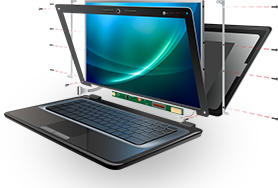If so, you might be asking the wrong question.
Nvidia’s G-sync technology has been available for laptops as far back as 2015 and is becoming more and more popular in the gaming industry to provide a superior gaming experience by removing the amount of noticeable tearing and stuttering in high motion graphics. So we understand that when a customer has damaged their screen and they need a replacement, they don’t want a regular screen like the other laptops, they want a G-sync screen. Except that for laptops G-sync is not a screen technology but a graphics card technology and the GPU synchronizes the refresh rates to match your LCD’s.
The reason for the confusion comes down to how it works when compared to desktop screens, because for a desktop the standalone monitor needs to have a built in g-sync module which replaces the standard built in scaler, which is connected the LCD panel. So the LCD panel is still the same, but it’s the module connected to the LCD that allows for G-sync. In laptops the LCD panel is connected directly to your graphics card, therefore this module is not required.
As long as your laptop’s graphics card supports G-syncing you do not need to worry about purchasing a G-sync compatible replacement, as it will be by default.
Can I upgrade my screen to be G-sync compatible?
Again this is the wrong question. Changing your LCD to a different type does not give or take away your laptop’s G-sync capabilities, it’s the graphics card you need to look at first.
Here is a link to Nvidia’s website for the minimum requirements and other FAQ’s regarding G-Sync (scroll down for a list of G-sync compatible mobile GPUs): http://www.geforce.com/hardware/technology/g-sync/faq
It should be noted however because of the multiple brands manufacturing screens today and any revisions they have done to previous models there is a small chance you may encounter a problem with a replacement screen not syncing correctly. However this problem is actually resolved through fine tuning in the graphics settings.
Copyright (©) LaptopScreen.com
